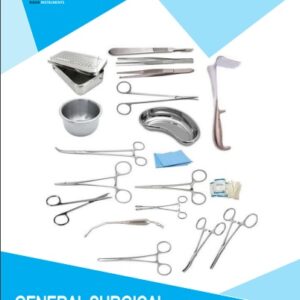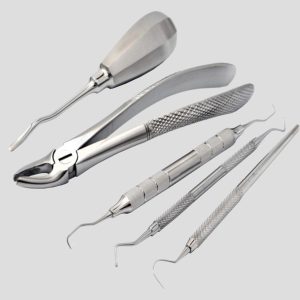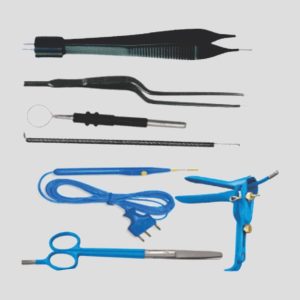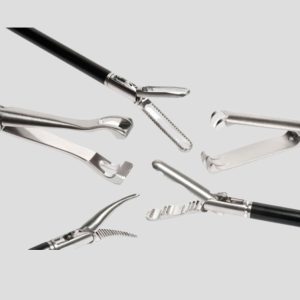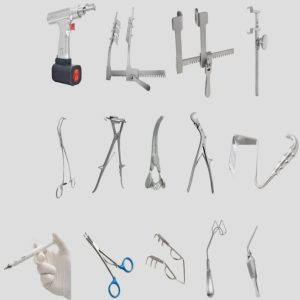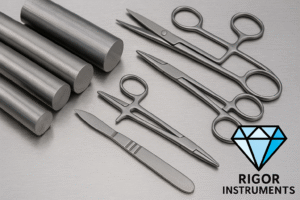
Selecting the right type of stainless steel is critical in manufacturing surgical instruments because it directly impacts patient safety, instrument performance, and product lifespan. Here’s why it matters:
- Corrosion Resistance
- Why it’s important: Instruments are exposed to blood, saline, disinfectants, and sterilization cycles (autoclaves, chemicals).
- Impact: The wrong steel can corrode, pit, or rust—compromising hygiene and increasing infection risks.
- Mechanical Strength & Hardness
- Why it’s important: Cutting, clamping, and holding instruments need to maintain sharp edges and resist wear under pressure.
- Impact: A softer steel may dull quickly or deform, affecting surgical precision and safety.
- Bio compatibility
- Why it’s important: Materials must not react with body tissues or fluids.
- Impact: Poor choices may cause allergic reactions, toxicity, or inflammation.
- Heat & Chemical Resistance
- Why it’s important: Instruments must endure repeated steam sterilization (134°C+), and exposure to cleaning chemicals.
- Impact: Inadequate steel can discolor, degrade, or lose strength over time.
- Longevity & Cost Efficiency
- Why it’s important: Durable materials reduce replacement frequency and long-term costs.
- Impact: High-grade steel means fewer repairs, better performance, and higher customer satisfaction.
- Manufacturing Suitability
- Why it’s important: Some instruments require fine machining, welding, or hardening processes.
- Impact: Using the wrong steel can cause defects, poor finishes, or low precision.
In Surgical Instruments most commonly used steel are as follows:
Type | Grade Examples | Key Properties | Common Use |
Austenitic | 304, 316, 316L | Corrosion-resistant, non-magnetic | Trays, implants, cannulas |
Martensitic | 410, 420, 440A/B/C | Hard, strong, can be sharpened | Scalpels, scissors, forceps |
Precipitation-Hardened | 17-4 PH | High strength & corrosion resistance | Complex instruments, precision parts |
- Austenitic Stainless Steel (300 Series)
- Examples: 304, 316, 316L
- Properties:
- High corrosion resistance
- Non-magnetic
- Easily formable and weldable
- Applications:
- Cannulas, surgical trays, implants, and orthopedic devices
- Martensitic Stainless Steel (400 Series)
- Examples: 410, 420, 440A, 440B, 440C
- Properties:
- High hardness and strength
- Can be heat-treated
- Moderate corrosion resistance
- Applications:
- Cutting instruments (scissors, scalpels, forceps, needle holders)
- 420 is most common for surgical blades
- 440C is used for premium cutting tools due to its high hardness
9. Precipitation-Hardened Stainless Steel
- Examples: 17-4 PH (Type 630)
- Properties:
- High strength and corrosion resistance
- Good dimensional stability
- Applications:
- Complex surgical instruments that require strength and precision
Summary: What Happens If You Choose the Wrong Steel?
Wrong Steel Property | Potential Problem |
Low corrosion resistance | Rust, contamination, infections |
Insufficient hardness | Blunt edges, reduced cutting performance |
Poor bio-compatibility | Allergic reaction, implant failure |
Low heat resistance | Deformation during autoclave |
Incompatible with machining | Cracking, poor shape, we |
At Rigor Instruments, we use only the highest-grade medical stainless steel, including 420, 440C, and 17-4 PH, sourced from certified mills. Every batch undergoes strict quality control to ensure it meets international standards for corrosion resistance, hardness, and bio compatibility. For cutting instruments like scissors and scalpels, we use martensite stainless steel (420/440C) for superior edge retention and durability. For implants and components exposed to high moisture, we utilize 316L and 17-4 PH, offering excellent corrosion protection. Our in-house cold and hot forging facilities guarantee precise shaping and strength without compromising the steel’s micro-structure. This ensures every Rigor instrument delivers long-term performance, resistance to wear, and complete safety in surgical environments.






